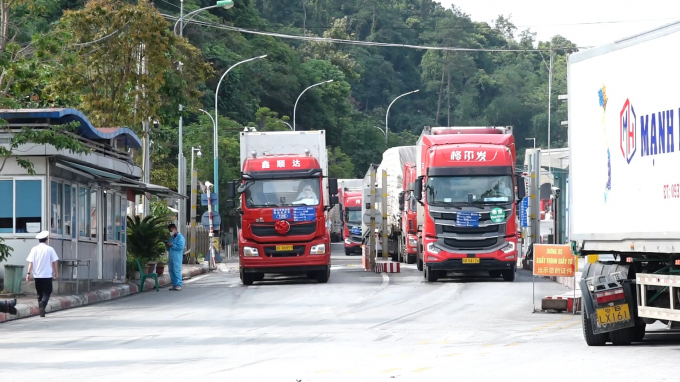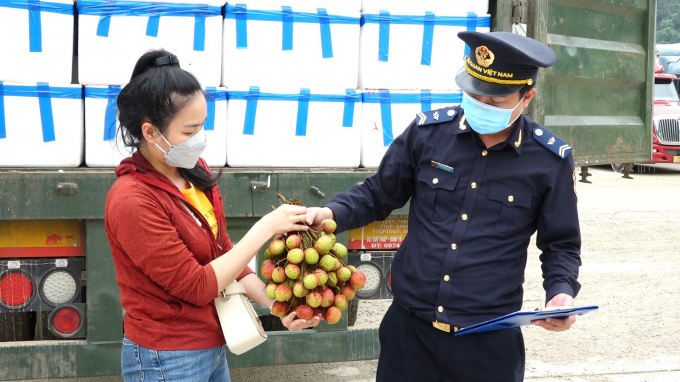November 27, 2025 | 19:52 GMT +7
November 27, 2025 | 19:52 GMT +7
Hotline: 0913.378.918
November 27, 2025 | 19:52 GMT +7
Hotline: 0913.378.918
Over the past time Lang Son has implemented a series of synchronous solutions from setting up a buffer zone, creating a green zone to strictly complying with the Covid-19 prevention and control procedure in import and export activities at the border gates. Thanks to joint efforts, clearance of import and export goods through border gates in Lang Son has taken place quite smoothly with increasing clearance capacity.

Trucks carrying agro-products are waiting for customs clearance procedures at Huu Nghi international border gate. Photo: Trang Anh.
According to statistics from July 1 to 11, at the border gates of Lang Son province, over 3,155 fruit trucks were exported, accounting for 90% of goods exported to China. Huu Nghi international border gate exported over 1,130 fruit trucks and Tan Thanh border gate exported over 2,000 fruit trucks. As of 8 pm on July 11, 176 fruit trucks were left at border gates, accounting for nearly 64% of the number of trucks with goods in stock in Lang Son. The average daily export to China through Tan Thanh border gate of Lang Son is approximately 300 trucks, mainly fruits and other agro-products.
Export through border gates in Lang Son going well at the present time is a good sign as many kinds of Vietnamese fruits are entering the main stage of the harvest season.
In particular, fresh lychee is always an item of priority with about 100 trucks being cleared every day. The reason is that fresh lychee is a perishable item, usually preservable for only 3 - 4 days. In the context of hot weather conditions, the functional forces at the border gate have prepared all favorable conditions for this product to be cleared as quickly as possible. This applies to other agro-products that are perishable and at the peak harvest season.
According to statistics, the average daily export to China through Tan Thanh border gate of Lang Son is approximately 300 trucks, mainly fruits and other agro-products. Accumulated from May 26 to July 10, more than 2,300 trucks of fresh lychee were cleared through this border gate with a total export volume of nearly 58,000 tons.
In order to ensure that export goods especially agro-products and fruits are not congested and stored for a long time, Lang Son province has actively exchanged and agreed with the Guangxi - China side to build, deploy and regularly adjust new import and export freight forwarding methods in line with reality.
The People's Committee of Lang Son province has proposed a number of solutions such as implementing a plan to establish a 3-layer "green zone" or cutting - connecting containers and using a team of drivers specialized in transporting goods across the border, creating stability in import and export activities in recent times.

Functional forces inspecting fresh lychees before exporting. Photo: Trang Anh.
Mr. Nguyen Anh Tai, Deputy Director of Lang Son Customs Department, said, “The Department has directed the branches on the border gate to prioritize the flow of agro-products for export, especially at times of frequent congestion. They will regularly grasp and monitor the situation in the area to promptly solve problems and avoid incurring costs for businesses.”
Also according to Lang Son Customs Department, currently there are no problems with customs procedures for exporting agro-products. The products have been 100% automatically processed by the customs system and completed in a very short time (about 3-4 seconds). Almost 100% of agricultural product shipments especially the export of fresh fruits do not carry out a physical inspection of the goods. The only problems of agricultural product congestion at the border gate in Lang Son province at present are mainly related to delivery and regulation of means of transport and goods crossing the border.
It is forecasted that in the near future the number of trucks carrying agro-products for export heading towards the border gates in Lang Son will increase. The local authorities are continuing the coordination to closely monitor the import and export of goods as well as the backlog of agro-products at the border gate area; proactively review and disseminate information to commodity owners in need of support and guidance on the implementation of agro-product consumption measures, contributing to minimizing economic losses for goods owners.
Translated by Samuel Pham

(VAN) After the institutional merger, Da Nang possesses significant forest-carbon reserves and is proactively engaging in the carbon market, creating a new revenue stream.

(VAN) An Giang strengthens communication against IUU fishing, increases inspections and sanctions, and is determined to remove the EC’s “yellow card” while developing a sustainable fisheries sector.

(VAN) As green transition becomes a global trajectory, Viet Nam’s biggest challenge is not only technology and models, but how to ensure that capital flows reach the right beneficiaries.

(VAN) The Ministry of Agriculture and Environment must spearhead the construction of green governance, spanning decision-making processes and investment standards to policy evaluation mechanisms.

(VAN) The Agriculture and Environment sector of Khanh Hoa has achieved numerous milestones over the past 80 years, contributing significantly to the goal of establishing the province as a centrally governed city by 2030.

(VAN) Viet Nam is entering the pivotal period of 2025-2030, moving toward the formulation of the Remote Sensing Law, which will establish a legal foundation for the development of national digital data.

(VAN) The agricultural sector is finalizing the strategic framework for emission reduction, setting the goal of sharply cutting methane and 403.7 million tons of CO2 equivalent and moving toward Net Zero by 2050.